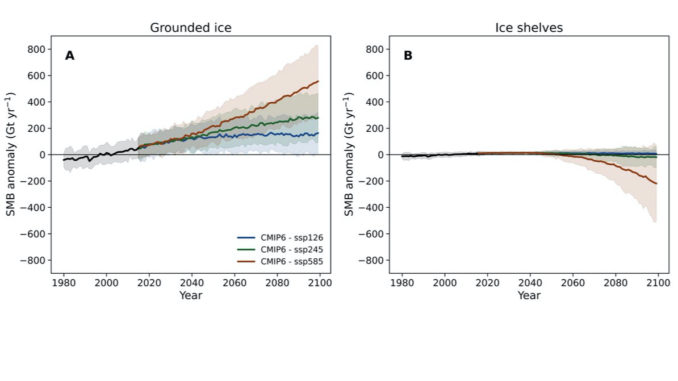
PROTECT paper #15 has been released! Diverging future surface mass balance between the Antarctic ice shelves and grounded ice sheet.
Here are the main findings:
- We use our regional climate model #MAR to downscale 2 #CMIP5 and 2 #CMIP6 models that were carefully selected over the #Antarctic ice sheet. From Earth to Antarctica using MAR.
- The surface mass balance (ie, difference between accumulation and erosion at the ice sheet surface) is projected to increase due to Global Warming.
- However, this positive trend hinds diverging local patterns with a decrease over the floating ice shelves (meltwater runoff >> snowfall) and an increase only over the grounded ice sheet (snowfall >> meltwater runoff).

- Furthermore, our results reveal a large spread by 2100 which could suggest important uncertainties for the future SMB. Really?

- Yes and no. The response of the Antarctic ice sheet depends solely on the warming predicted by the CMIP5 and CMIP6 models. In other words, the uncertainties are due to the timing and intensity of the warming 🌡️, not to different physical processes.

- There is therefore a direct link between warming 🌡️ and changes ↗️↘️ in SMB over both the grounded ice and the ice shelves. We then use this link to reconstruct the projected changes for all the CMIP5 and CMIP6 database.
- This reconstruction shows that the changes in SMB will be all the stronger with the new CMIP6 models. These new models project a stronger increase on the grounded part (🤗) and a stronger decrease on the ice shelves (😱) .

- We also find this feature for the Greenland ice sheet (@DrHofHof) https://twitter.com/DrHofHof/status/1338878963800825862…. But the SMB increase on the Antarctic grounded ice sheet will lead to a mitigation of the #sea_level_rise (SLR) versus opposite role that Greenland SMB projected changes.
- The SMB increase on the Antarctic grounded ice sheet will lead to a mitigation of the sea level rise by 5.1 ± 1.9 cm sea level equivalent (SLE) in CMIP5 (Relative Concentration Pathway 8.5) and 6.3 ± 2.0 cm SLE in CMIP6 (Shared Socioeconomic Pathways 585)
- Beware, this does not mean that Antarctica will lower the sea level, because the ice shelf melt (surface + ocean) will increase ice discharge into the ocean thus ultimately increase Antarctica’s contribution to the sea level.
- Furthermore, SMB is an input for mass balance projections and SLR contribution of the Antarctic Ice Sheet. Using our polar-oriented model, we find significant differences in raw SMB projections based on the models we use as forcing.

- The changes projected by MAR are stronger and this could partly call into question recent Antarctic mass balance projections (tc.copernicus.org/articles/14/30…).
- Limits of our study: MAR does not represent wind erosion of the snow (in this study), water surface hydrology, nor the melt/elevation feedbacks.
- Finally, our results reveal the existence of a potential threshold (+7.5°C compared to present day) that leads to a lower grounded-SMB increase. Need to know more because it could imply that even the surface of the Antarctic would no longer be able to mitigate the SLR.
- It is therefore important to respect the #ParisAgreement because they will make it possible to limit changes over the ice shelves surfaces, reduce the risk of their collapse due to hydrofracturing and then sea-level rise.

